Written by Angela Goodwin
First and foremost you will want to have all of the proper gear for the kind of fishing you will be doing. There are so many different things on the market for fly fishing today than there was fifty years ago. The basic necessities include: rods, reels, flies, tackle boxes, hip boots or waders, flotation vest, fish vest, fish basket and fishing license.
The second step is to figure out what kind of fish you are after: trout, salmon, bass etc.? Will you be fishing in shallow, slow running, small streams for small fish, or in deep strong currents and big fish? Also, if you are fishing in saltwater; what kind of fish and where are you fishing. For different waters and fish, different flies and tackle are needed.
Learning the hand and wrist technique
Before you begin, pull up to 10 yards of line from your fly rod. Most fly rods are suited with a cork grip. With your hand gripping around the cork and your thumb placed on top, begin a back and forth motion. The wrist should move backward at a comfortable angle and then forward. When you are ready to release the line, snap your wrist in a forward motion to release.
This is a very basic explanation for the hand and wrist technique, but there are many video’s and other information out there and on the Internet.
Knowing what kind of fishing you will be doing will help you decide what size of rod, reel and line weight you will need.
Rods: A nine foot rod is the average length. Depending on was size of water you will be fishing in and what size of fish you will be catching will depend on the size of rod to use.
The other difference with rods is the action or (flex). The action is how fast the rod will return to it’s position after being flexed.
Reels: A single action reel is easiest to begin learning. They should have adjustable drags so when you are fighting and trying to play it out, you can control the amount of friction. If the drag is too tight, there is the chance the fish could snap the leader and swim off with your fly. Adjusting for the drag for the size and fight helps to play it out.
The multiplier is another reel, but mostly used by more experienced anglers. Each time the handle rotates, the spool rotates more.
Go to your local sports store and ask them for help getting the proper gear for what you want to do.
Fishing Line: A lighter weight line is used with lighter rods for casting small flies and is used in smaller streams. Heavy weight lines are used with heavier rods to cast larger flies and cast them further.
A floating line is used to present the fly near the surface of the water. A good time to use these flies is in the early morning and evening when insects are flying just above the surface of the water.
An intermediate line is a slow sinking line.
A sinking line falls through the water presenting the fly on the bottom.
The sinking tip line sinks to a certain depth. Depending on how much of the line is weighted is how far the line will sink.
The double taper line is used on both sides, so that when one side wears out, the other side can be used.
Flies:
A dry fly floats and is used for fishing the surface of the water. Some of the more common names for dry flies are: Adams, Elk Hair Caddis, Gray Wulff, Griffith’s Gnat.
A wet fly or as commonly called, the nymph, is used for fishing near the bottom of the water. Some of the more common names for nymphs are: Wooly Bugger, Gold Ribbed Hare’s Ear, Pheasant Tail, and Mayflies.
Saltwater Fly: Is used mostly in warm ocean waters and often is made to look like ocean crustacean. Some examples of the salt water fly are: Pink Shrimp, Deceiver, Deep Hair Squid and the Shady Lady Squid.
Remember when fishing any area use the kind of fly that is more natural to the area. And, use a small box with compartments in it to protect your flies from damage or blowing away, as they are lightweight lures.
Learning to tie your own flies
There are many books on tying your own flies. I looked in the local library and found several. They will explain step by step, what equipment you will need and how to tie a fly from the beginning to end.
Gear:
- Fishing Rod & Reel
- Fishing Line
- Rain gear
- Cold weather gear
- Hip Boots
- Waders
- Flotation Device
- Fish Basket
Fishing Vest for carrying:
- Fishing License
- Tackle
- Knife
- Fingernail clippers
- First Aid Kit
Cooking Fish:
There is a couple of different ways to cook small fish. Simply lay the fish in hot oil and fry with the skin on, or roll in flour and fry. Smoking trout is another option.
There are several options to preparing salmon. They can be baked or broiled in an oven in aluminum foil with added ingredients such as butter, onions and chives.
They can also be canned, smoked, or both.
Resources & Interesting books I found in the library:
FLY TYING MADE CLEAR AND SIMPLE– Tools and materials: the different types of flies and how to tie them.
SALTWATER FLY TYING– Tools and materials: the different types of flies and how to tie them.
TACTICS FOR TROUT– discusses the many different types of trout and what kind of fly to use, depending on what the fish are eating.
EVEN BROOK TROUT GET THE BLUES– This book is all about fishing and the outdoors.
Here are a few websites to help get you started



Follow us for the latest news!